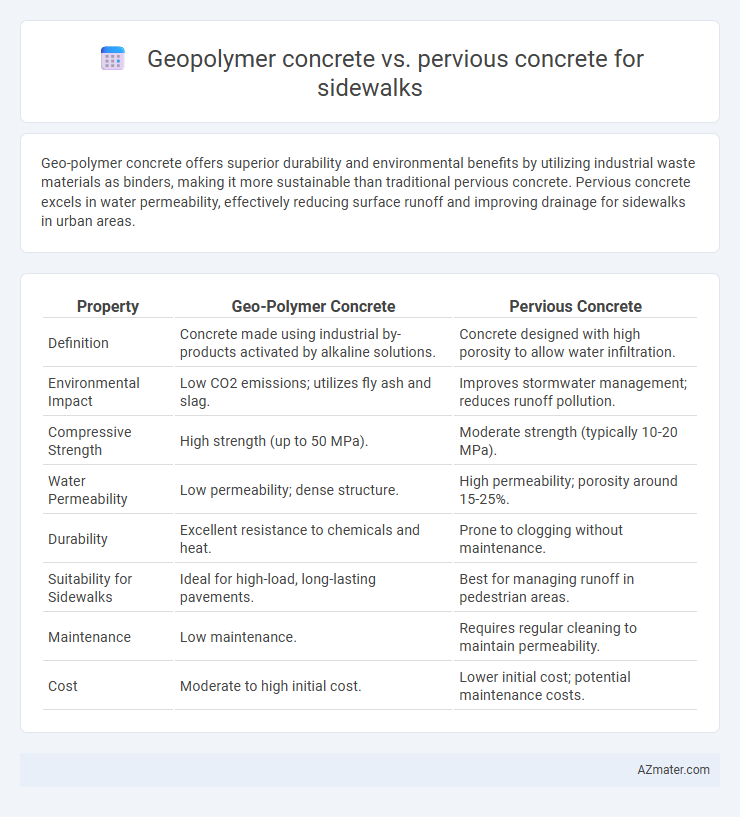Geo-polymer concrete offers superior durability and environmental benefits by utilizing industrial waste materials as binders, making it more sustainable than traditional pervious concrete. Pervious concrete excels in water permeability, effectively reducing surface runoff and improving drainage for sidewalks in urban areas.
Table of Comparison
| Property | Geo-Polymer Concrete | Pervious Concrete |
|---|---|---|
| Definition | Concrete made using industrial by-products activated by alkaline solutions. | Concrete designed with high porosity to allow water infiltration. |
| Environmental Impact | Low CO2 emissions; utilizes fly ash and slag. | Improves stormwater management; reduces runoff pollution. |
| Compressive Strength | High strength (up to 50 MPa). | Moderate strength (typically 10-20 MPa). |
| Water Permeability | Low permeability; dense structure. | High permeability; porosity around 15-25%. |
| Durability | Excellent resistance to chemicals and heat. | Prone to clogging without maintenance. |
| Suitability for Sidewalks | Ideal for high-load, long-lasting pavements. | Best for managing runoff in pedestrian areas. |
| Maintenance | Low maintenance. | Requires regular cleaning to maintain permeability. |
| Cost | Moderate to high initial cost. | Lower initial cost; potential maintenance costs. |
Introduction to Geo-polymer and Pervious Concrete
Geo-polymer concrete is an eco-friendly alternative to traditional cement-based concrete, composed primarily of industrial byproducts such as fly ash or slag activated by alkaline solutions, offering high durability and reduced carbon footprint. Pervious concrete features a porous structure designed to allow water infiltration, enhancing stormwater management and reducing runoff on sidewalks. Both materials provide sustainable solutions, with geo-polymer concrete emphasizing strength and environmental impact, while pervious concrete focuses on permeability and water drainage.
Composition and Material Properties
Geo-polymer concrete for sidewalks utilizes industrial by-products like fly ash or slag combined with alkaline activators, resulting in a binder with high compressive strength, chemical resistance, and low carbon footprint. Pervious concrete comprises a mixture of coarse aggregates, minimal fine aggregates, and cement paste, designed to achieve high porosity and permeability for effective stormwater infiltration but typically exhibits lower compressive strength. The superior durability and environmental benefits of geo-polymer concrete contrast with the exceptional permeability and water management capabilities of pervious concrete, making each material suited to different functional sidewalk requirements.
Environmental Sustainability Comparison
Geopolymer concrete offers superior environmental sustainability for sidewalks by utilizing industrial by-products like fly ash and slag, significantly reducing CO2 emissions compared to traditional Portland cement-based pervious concrete. Pervious concrete enhances stormwater management and groundwater recharge but typically relies on cement with higher carbon intensity. The adoption of geopolymer concrete in pedestrian pathways effectively lowers carbon footprint while maintaining permeability and durability, positioning it as a more sustainable choice for urban infrastructure.
Mechanical Strength and Durability
Geo-polymer concrete exhibits higher mechanical strength and superior durability compared to pervious concrete, making it more suitable for high-traffic sidewalks. Its chemical resistance and lower permeability reduce the risk of cracking and damage from freeze-thaw cycles, unlike pervious concrete which prioritizes permeability over strength. The enhanced compressive strength of geo-polymer concrete typically ranges from 40 to 60 MPa, whereas pervious concrete usually offers 15 to 25 MPa but excels in stormwater management.
Permeability and Drainage Efficiency
Geo-polymer concrete offers enhanced durability and chemical resistance compared to traditional materials, but its permeability is generally lower than pervious concrete, making it less effective for rapid water infiltration. Pervious concrete excels in permeability and drainage efficiency, allowing rainwater to quickly seep through the sidewalk surface, reducing runoff and promoting groundwater recharge. For sidewalk applications requiring superior drainage performance, pervious concrete provides significant advantages in managing stormwater and preventing surface puddling.
Installation Process and Workability
Geo-polymer concrete requires precise mixing of alkaline activators with industrial byproducts like fly ash, demanding careful control of curing temperature and time to achieve optimal strength and durability in sidewalk applications. Pervious concrete features a higher porosity mix design with larger aggregate sizes, enabling quicker installation due to rapid water permeability but requiring careful compaction to avoid clogging and ensure structural integrity. Workability in geo-polymer concrete is often lower than conventional mixes, necessitating skilled labor, whereas pervious concrete offers better workability but needs specialized handling to maintain its void structure.
Cost Analysis and Economic Viability
Geo-polymer concrete offers a lower carbon footprint and enhanced durability compared to pervious concrete, resulting in reduced long-term maintenance costs for sidewalks. Initial material costs for geo-polymer concrete are typically higher, but the overall economic viability improves due to extended service life and decreased repair frequency. Pervious concrete is generally less expensive upfront but may incur higher maintenance expenses related to clogging and reduced permeability over time, impacting its cost-effectiveness in sidewalk applications.
Maintenance and Longevity
Geo-polymer concrete offers superior chemical resistance and durability compared to pervious concrete, resulting in lower maintenance requirements and extended lifespan for sidewalks. Pervious concrete provides excellent water drainage but tends to clog over time, necessitating frequent cleaning and repairs to maintain permeability. Choosing geo-polymer concrete can minimize long-term maintenance costs while enhancing sidewalk longevity under heavy foot traffic and environmental exposure.
Performance in Various Climate Conditions
Geo-polymer concrete exhibits superior durability and resistance to chemical attacks in diverse climate conditions, making it ideal for sidewalks exposed to freeze-thaw cycles and deicing salts. Pervious concrete enhances water drainage and reduces surface runoff but may suffer from clogging and reduced strength in extreme cold or heavy rainfall environments. Selecting geo-polymer concrete for sidewalks ensures long-term structural integrity, while pervious concrete offers environmental benefits in moderate climates with adequate maintenance.
Best Use Cases for Sidewalk Applications
Geo-polymer concrete offers superior durability and chemical resistance, making it ideal for sidewalks exposed to harsh environmental conditions or chemical spills. Pervious concrete excels in stormwater management by allowing water to pass through, reducing runoff and preventing flooding in urban areas. Selecting Geo-polymer concrete suits high-traffic, industrial sidewalk zones, while pervious concrete is best for residential and park walkways requiring sustainable drainage solutions.

Infographic: Geo-polymer concrete vs Pervious concrete for Sidewalk
 azmater.com
azmater.com